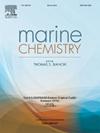粉尘沉积直接影响海洋中溶解有机碳的浓度
IF 2.5
3区 地球科学
Q2 CHEMISTRY, MULTIDISCIPLINARY
引用次数: 0
摘要
尘埃沉积到海洋中,由于通过施肥刺激初级生产,在碳循环中起间接作用。此外,它还作为海洋聚集体的压舱物将碳输送到海底。尽管有这些公认的影响,但灰尘-海水相互作用对碳循环的直接影响仍然知之甚少。本文通过时间序列和稳定碳同位素分析,研究了矿物粉尘对海水中溶解有机碳(DOC)浓度的吸附作用。我们将两种不同数量的粉尘加入人工海水和螺旋藻提取物中13c标记的溶解有机物的溶液中,创建了低和高粉尘-海水比系统。72h后,我们观察到两种体系的DOC都有所下降,这表明螺旋藻提取物中的DOC被吸附在粉尘颗粒上。在吸附实验前后,对尘埃样品中总有机碳的稳定碳同位素比率进行了分析,证实了这些发现。此外,我们的研究表明,灰尘对DOC的净吸收量取决于有机碳的吸附、释放和降解的相对重要性。从扬尘与海水的比值和扬尘上的初始有机碳来看,DOC释放可以成为主导过程,说明扬尘在近地表水体中既是有机碳的汇源,也是有机碳的源源。本文章由计算机程序翻译,如有差异,请以英文原文为准。

Dust deposition directly affects the concentration of dissolved organic carbon in the ocean
Dust deposition to the ocean plays an indirect role in the carbon cycle due to stimulating the primary production by fertilisation. Additionally, it transports carbon to the ocean floor by acting as ballast for marine aggregates. Despite these recognized impacts, the direct influence of dust-seawater interactions on the carbon cycle remains poorly understood. Here, we study the effects of mineral dust on the dissolved organic carbon (DOC) concentration in seawater by performing sorption experiments through time series and stable carbon isotope analysis. We added two different amounts of dust to a solution of artificial seawater and 13C-labelled dissolved organic matter from Spirulina extract, creating a low and high dust-seawater ratio system. After 72 h, we observe a decrease in DOC for both systems, indicating the adsorption of DOC from the Spirulina extract onto dust particles. Analysis of the stable carbon isotope ratios of total organic carbon on the dust samples, before and after the sorption experiments, confirms these findings. Furthermore, our study shows that the net uptake of DOC on dust depends on the relative importance of adsorption, release and degradation of organic carbon. DOC release can become the dominant process based on the dust-seawater ratio and the initial organic carbon present on the dust, demonstrating that dust can act as both a sink and a source of organic carbon in the near-surface waters.
求助全文
通过发布文献求助,成功后即可免费获取论文全文。
去求助
来源期刊

Marine Chemistry
化学-海洋学
CiteScore
6.00
自引率
3.30%
发文量
70
审稿时长
4.5 months
期刊介绍:
Marine Chemistry is an international medium for the publication of original studies and occasional reviews in the field of chemistry in the marine environment, with emphasis on the dynamic approach. The journal endeavours to cover all aspects, from chemical processes to theoretical and experimental work, and, by providing a central channel of communication, to speed the flow of information in this relatively new and rapidly expanding discipline.
 求助内容:
求助内容: 应助结果提醒方式:
应助结果提醒方式:


